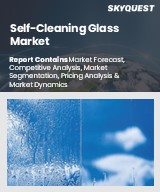
세계의 셀프 클리닝 유리 시장 규모는 2023년에 1,253억 달러로 평가되며, 2024년 1,310억 6,000만 달러에서 2032년에는 1,878억 2,000만 달러로 성장하며, 예측 기간(2025-2032년)의 CAGR은 4.6%로 성장할 전망입니다.
세계 셀프 클리닝 유리 시장은 지속가능하고 유지보수가 적은 건축자재에 대한 선호도가 높아짐에 따라 크게 성장하고 있습니다. 도시화의 진전과 환경에 대한 인식이 높아짐에 따라 셀프 클리닝 유리 시스템의 채택이 증가하고 있습니다. 특히 광촉매 코팅과 친수성 코팅의 기술적 진보로 인해 이러한 제품의 효율이 향상되어 더욱 광범위하게 사용되고 있습니다. 또한 그린 빌딩 실천을 장려하는 지방정부의 구상은 시장의 채택을 더욱 촉진하고 있습니다. 에너지 효율이 높은 소재에 대한 수요 증가와 세척 비용 절감의 필요성이 결합되면서 셀프 클리닝 유리에 대한 관심이 높아지고 있으며, 지속가능성과 비용 효율성을 중시하는 현대식 건축 및 리노베이션 프로젝트에 적합한 대안으로 자리매김하고 있습니다.
Global Self-Cleaning Glass Market size was valued at USD 125.3 billion in 2023 and is poised to grow from USD 131.06 billion in 2024 to USD 187.82 billion by 2032, growing at a CAGR of 4.6% during the forecast period (2025-2032).
The global self-cleaning glass market is experiencing significant growth driven by a rising preference for sustainable, low-maintenance building materials. Increasing urbanization and heightened environmental awareness are leading to the adoption of self-cleaning glass systems in more structures. Technological advancements, particularly in photocatalytic and hydrophilic coatings, are improving the efficiency of these products, facilitating their wider use. Additionally, local government initiatives promoting green building practices are further boosting market adoption. The escalating demand for energy-efficient materials combined with the need to reduce cleaning costs is also propelling interest in self-cleaning glass, positioning it as a preferred choice for modern construction and renovation projects focused on sustainability and cost-effectiveness.
Top-down and bottom-up approaches were used to estimate and validate the size of the Global Self-Cleaning Glass market and to estimate the size of various other dependent submarkets. The research methodology used to estimate the market size includes the following details: The key players in the market were identified through secondary research, and their market shares in the respective regions were determined through primary and secondary research. This entire procedure includes the study of the annual and financial reports of the top market players and extensive interviews for key insights from industry leaders such as CEOs, VPs, directors, and marketing executives. All percentage shares split, and breakdowns were determined using secondary sources and verified through Primary sources. All possible parameters that affect the markets covered in this research study have been accounted for, viewed in extensive detail, verified through primary research, and analyzed to get the final quantitative and qualitative data.
Global Self-Cleaning Glass Market Segments Analysis
Global Self-Cleaning Glass Market is segmented by Coating Type, Application, End-user Industry and region. Based on Coating Type, the market is segmented into Hydrophilic Coating and Hydrophobic Coating. Based on Application, the market is segmented into Facades and Windows, Roofs and Skylights, Solar Panels and BIPV, Mirrors and Glass Partitions and Vehicle Windscreens and Sunroofs. Based on End-user Industry, the market is segmented into Buildings and Construction, Automotive and Transportation, Solar Energy (PV and CSP), Consumer Electronics and Appliances and Others. Based on region, the market is segmented into North America, Europe, Asia Pacific, Latin America and Middle East & Africa.
Driver of the Global Self-Cleaning Glass Market
The Global Self-Cleaning Glass market is witnessing significant growth, driven by the increasing demand for energy-efficient structures across various sectors, particularly in construction. With environmental concerns taking center stage, governments are implementing stringent regulations that encourage the adoption of innovative technologies. Self-cleaning glass stands out due to its ability to conserve energy and minimize the costs and efforts associated with maintenance and manual cleaning. As architects and builders recognize its advantages for both commercial and residential projects, the adoption of self-cleaning glass is expected to rise, further propelling market expansion and solidifying its status as a preferred material in modern construction.
Restraints in the Global Self-Cleaning Glass Market
The global self-cleaning glass market faces obstacles primarily due to its high cost compared to traditional glass. The use of advanced nanocoatings, such as titanium dioxide, along with intricate manufacturing techniques, contributes to elevated production expenses, which can deter budget-sensitive consumers and small-scale projects. Although the technology offers potential long-term benefits in terms of maintenance and energy savings, the initial financial outlay presents a significant challenge, especially in developing regions where affordability is a critical concern. Consequently, this pricing dynamic limits widespread adoption and market growth.
Market Trends of the Global Self-Cleaning Glass Market
The Global Self-Cleaning Glass market is experiencing a transformative phase driven by advancements in nanotechnology, increasing durability, and superior self-cleaning capabilities. This growth is fueled by the rising demand for energy-efficient buildings and the need for minimized maintenance costs. Market opportunities are expanding with the integration of self-cleaning glass into smart building management systems utilizing sensors and IoT technology. Moreover, ongoing research into anti-bacterial and anti-viral coatings significantly enhances market attractiveness. Innovations within the sector are further enriched by the incorporation of self-cleaning glass into solar panels and automotive applications, paving the way for substantial market expansion.